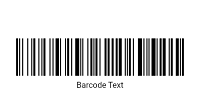The Universal Product Code (UPC) is a barcode symbology widely used for identifying retail products. It provides a standardized method for encoding product information, facilitating efficient tracking and sales processing in the retail environment. Developed in the early 1970s, UPC barcodes are a cornerstone of modern retail and inventory management.
The UPC barcode was introduced in 1973 by George Laurer and his team at IBM. It was created to address the need for a standardized system to streamline product identification and checkout processes. The UPC system was initially implemented to replace manual pricing and inventory methods, significantly improving efficiency and accuracy in retail settings.
Technical Specifications
The UPC barcode is designed to encode numeric data in a 12-digit format. The most common version of UPC is UPC-A, which encodes 11 digits of data plus a check digit, and UPC-E, a compact version used for smaller packages. The structure of a UPC barcode includes:
- Start and Stop Characters: These characters are not explicitly shown in the barcode but are part of the overall structure used to signal the beginning and end of the data sequence.
- Data Digits: The UPC-A barcode consists of 12 digits arranged in a specific format. The first 6 digits represent the manufacturer code, the next 5 digits represent the product code, and the final digit is a check digit used for error detection.
- Checksum: The check digit is calculated using the modulo 10 algorithm to verify the accuracy of the encoded data.
Checksum Calculation
The check digit in a UPC barcode is determined using the following steps:
- Multiply each digit by a weight factor. For UPC-A, the weight factors alternate between 1 and 3, starting with the rightmost digit.
- Sum the results of these multiplications.
- Compute the remainder when this sum is divided by 10.
- Subtract the remainder from 10 to determine the check digit. If the remainder is 0, the check digit is also 0.
This checksum method helps in detecting errors in the barcode data, ensuring accurate scanning and processing.
Advantages and Disadvantages
The UPC barcode provides several benefits, including its simplicity, widespread adoption, and ease of integration with point-of-sale systems. Its fixed length of 12 digits ensures a uniform format that can be easily read by scanners.
However, the UPC barcode is limited to numeric data, which restricts its use in applications requiring alphanumeric information. Additionally, its fixed length may not accommodate all product identification needs, leading to the development of other barcode symbologies like EAN-13 for more extensive data encoding.
UPC Applications
The UPC barcode is extensively used in retail and other industries for various applications:
- Retail: It is prominently used on consumer products to facilitate checkout and inventory management. The UPC barcode streamlines the checkout process, allowing for quick scanning and accurate pricing.
- Supply Chain: UPC barcodes are employed in logistics and warehousing to track products through the supply chain, improving inventory accuracy and efficiency.
- Global Trade: The UPC system has become a global standard, making it easier to manage and track products across international markets.
Comparison with Other Barcode Symbologies
Compared to other barcodes like EAN-13, the UPC barcode is similar in functionality but differs in format. EAN-13 provides an additional digit, allowing for a broader range of product identifiers. Unlike more complex barcodes such as Code 128, which supports alphanumeric data, the UPC barcode focuses solely on numeric encoding. The UPC system is also more compact than some barcodes, making it suitable for consumer product labeling where space is limited.
The UPC barcode has become a fundamental tool in retail and supply chain management, offering a standardized and efficient method for product identification. Its development revolutionized the retail industry by streamlining checkout and inventory processes. Despite its limitations to numeric data and fixed length, the UPC barcode's simplicity, widespread adoption, and accuracy have made it an enduring standard in global commerce.


